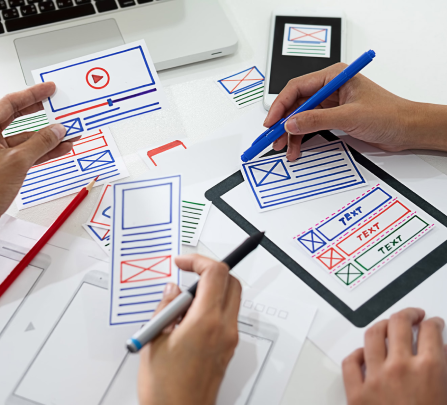Usability Testing:
Real Interactions in Action
Is your product easy to navigate and user-friendly in real-time?
Usability testing gives you a direct line to your users’ minds as they interact with a product or prototype. It helps validate your design decisions, identify missed pain points, and optimize user flows by gathering insightful feedback.
How does Usability Testing help refine design process?
Usability testing offers a unique perspective by observing real users interact with your product. It helps identify potential usability issues that might be overlooked in internal testing.
User feedback is used to refine the product iteratively, ensuring that it aligns with real-world needs and expectations, ultimately delivering a superior user experience.
Usability Testing is like a reality check for design decisions. By observing users interact with the product, designers can validate assumptions about how users will perceive and utilize features.
Identifying and addressing issues early in the development process prevents costly rework and delays later. It also helps allocate resources more effectively.
Satisfied users are more likely to recommend your product to others, expanding your reach. A well-designed product fosters user loyalty and repeat engagement.
How we approach Usability Testing
Plan and Set Goals
We meticulously plan each usability test, carefully defining objectives, tasks, and realistic scenarios that mirror real-world usage to ensure a focused and efficient testing process.
Recruit and
Create Tasks
A diverse group of users who represent your target audience are recruited to perform realistic tasks that simulate how users will interact with the product.
Conduct Test and Observe
Participants are guided through defined tasks while their behavior and expressions during the interactions are observed and their feedback is recorded.
Review and
Analyze Data
We study the data collected and identify patterns, trends, and areas for improvement to understand user behaviors, preferences, and pain points, that guide product improvement.
Report and Recommend
We generate a detailed report outlining our findings and providing actionable recommendations for design enhancements and guide future design iterations.
Key Metrics
Task completing
time and rate
User Satisfaction
error rate
ease of use
FAQs
Usability testing is a vital component of the design process that involves observing real users as they interact with a product or prototype. It serves as a bridge between the design team and the end-user, ensuring that the product is not only functional but also intuitive and enjoyable to use.
At Tentackles, we prioritize user-centered design. Our usability testing process involves designing test scenarios and tasks relevant to the product, recruiting representative participants, observing their interactions, and gathering feedback for actionable reports and recommendations.
Usability testing is most effective when conducted early in the development process, after initial design iterations and prototyping. This allows for timely identification and correction of usability issues before significant investments are made.
Yes. Remote testing is often more convenient and cost-effective, allowing you to recruit participants from a wider geographical area. In-person testing provides greater control over the environment and enables direct observation of participants’ body language and facial expressions.
Usability testing provides valuable insights into user behavior, helping designers make informed decisions to refine the product’s interface, layout, and overall functionality, ultimately resulting in a design that better meets users’ needs and drives adoption.
